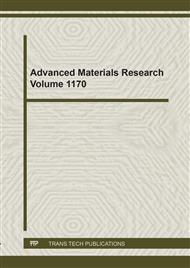[1]
M. H. Sehhat, A. Mahdianikhotbesara, Powder spreading in laser-powder bed fusion process, Granul. Matter, 23 (4) (2021) 1-18 ,.
DOI: 10.1007/s10035-021-01162-x
Google Scholar
[2]
M. H. Sehhat, B. Behdani, C. H. Hung, A. Mahdianikhotbesara, Development of an Empirical Model on Melt Pool Variation in Laser Foil Printing Additive Manufacturing Process Using Statistical Analysis, Metallogr. Microstruct. Anal., 10 (2021) 684-691,.
DOI: 10.1007/s13632-021-00795-x
Google Scholar
[3]
M. H. Sehhat, A. Mahdianikhotbesara, F. Yadegari, Impact of Temperature and Material Variation on Mechanical Properties of Parts Fabricated with Fused Deposition Modelling (FDM) Additive Manufacturing, PREPRINT (Version 1) available at Research Square (2021),.
DOI: 10.21203/rs.3.rs-1079840/v1
Google Scholar
[4]
M. H. Sehhat, A. T. Sutton, C. H. Hung, J. W. Newkirk, M. C. Leu, Investigation of Mechanical Properties of Parts Fabricated with Gas- and Water-Atomized 304L Stainless Steel Powder in the Laser Powder Bed Fusion Process, JOM, (2021) 1-10,.
DOI: 10.1007/s11837-021-05029-7
Google Scholar
[5]
M. H. Sehhat, A. Mahdianikhotbesara, F. Yadegari, PREPRINT (Version 1) available at Research Square (2021),.
Google Scholar
[6]
T. Turk, C. H. Hung, M. H. Sehhat, M. C. Leu, Methods of Automating the Laser-Foil-Printing Additive Manufacturing Process, Proceedings of the 32nd Annual International Solid Freeform Fabrication Symposium – An Additive Manufacturing Conference, (2021).
DOI: 10.32656/2018_29sff_symposium
Google Scholar
[7]
T. Liu, C. S. Lough, M. H. Sehhat, J. Huang, E. C. Kinzel, M. C. Leu, In-Situ Thermographic Inspection for Laser Powder Bed Fusion, Proceedings of the 32nd Annual International Solid Freeform Fabrication Symposium – An Additive Manufacturing Conference, (2021).
DOI: 10.1016/j.addma.2022.102873
Google Scholar
[8]
M. H. Sehhat, J. Chandler, Z. Yates, A review on ICP powder plasma spheroidization process parameters, Int. J. Refract. Met. Hard. Mater. (2021) 1-26.
DOI: 10.1016/j.ijrmhm.2021.105764
Google Scholar
[9]
M. H. Sehhat, A. Mahdianikhotbesara, M. Hadad, Formability Investigation for Perforated Steel Sheets, SAE MobilityRxiv Preprint, (2021),.
DOI: 10.47953/sae-pp-00182
Google Scholar
[10]
R. S. Mishra, Z. Y. Ma, Friction stir welding and processing, Mater. Sci. Eng. R reports, 50 (1) (2005) 1–78.
Google Scholar
[11]
Y. J. Chao, X. Qi, Thermal and thermo-mechanical modeling of friction stir welding of aluminum alloy 6061-T6, JMPMS, 7 (2) (1998) 215–233.
DOI: 10.1106/ltkr-jfbm-rgmv-wvcf
Google Scholar
[12]
H. Schmidt, J. Hattel, J. Wert, An analytical model for the heat generation in friction stir welding, Model. Simul. Mater. Sci. Eng., 12 (1) (2003).
DOI: 10.1088/0965-0393/12/1/013
Google Scholar
[13]
M. Chiumenti, M. Cervera, C. A. de Saracibar, N. Dialami, Numerical modeling of friction stir welding processes, Comput. Methods Appl. Mech. Eng., 254 (2013) 353–369.
DOI: 10.1016/j.cma.2012.09.013
Google Scholar
[14]
N. Najafizadeh, M. Rajabi, R. Hashemi, S. Amini, A method and apparatus for determination of the ultrasonic-assisted forming limit diagram, Proc. Inst. Mech. Eng. Part C J. Mech. Eng. Sci., (2021),.
DOI: 10.1177/09544062211011509
Google Scholar
[15]
N. Najafizadeh, M. Rajabi, R. Hashemi, S. Amini, "Improved microstructure and mechanical properties of sheet metals in ultrasonic vibration enhanced biaxial stretch forming, J. Theor. Appl. Vib. Acoust., 5 (1) (2019) 1–10,.
Google Scholar
[16]
M. Assidi, L. Fourment, S. Guerdoux, T. Nelson, Friction model for friction stir welding process simulation: Calibrations from welding experiments, Int. J. Mach. Tools Manuf., 50 (2) (2010) 143–155.
DOI: 10.1016/j.ijmachtools.2009.11.008
Google Scholar
[17]
Z. Zhang, W. U. Qi, H. Zhang, Numerical studies of effect of tool sizes and pin shapes on friction stir welding of AA2024-T3 alloy, Trans. Nonferrous Met. Soc. China, 24 (10) (2014) 3293–3301.
DOI: 10.1016/s1003-6326(14)63469-5
Google Scholar
[18]
G. Buffa, A. Ducato, L. Fratini, Numerical procedure for residual stresses prediction in friction stir welding, Finite Elem. Anal. Des., 47 (4) (2011) 470–476.
DOI: 10.1016/j.finel.2010.12.018
Google Scholar
[19]
F. Al-Badour, N. Merah, A. Shuaib, A. Bazoune, Coupled Eulerian Lagrangian finite element modeling of friction stir welding processes, J. Mater. Process. Technol., 213 (8) (2013) 1433–1439.
DOI: 10.1016/j.jmatprotec.2013.02.014
Google Scholar
[20]
G. K. White, S. J. Collocott, Heat capacity of reference materials: Cu and W, J. Phys. Chem. Ref. data, 13 (4) (1984).
Google Scholar
[21]
D. R. Lide, CRC handbook of chemistry and physics, CRC press, (2004).
Google Scholar
[22]
L. F. Mondolfo, Aluminum alloys: structure and properties, Elsevier, (2013).
Google Scholar
[23]
A. Rajak, S. Kore, Electromagnetic hemming of aluminum sheets using FEM, ICMMD-2016 Adv. Intell. Syst. Res., (2017) 77–82.
DOI: 10.2991/iccasp-16.2017.13
Google Scholar
[24]
B. T. Long, N. Cuong, N. H. Phan, H. A. Toan, P. Janmanee, Enhanced Material Removal Rate and Surface Quality of H13 Steel in Electrical Discharge Machining With Graphite Electrode in Rough Machining, Int. J. Sci. Eng. Technol., 4, (2) (2015) 101–106.
DOI: 10.17950/ijset/v4s2/216
Google Scholar
[25]
G. E. Totten, D. S. MacKenzie, Handbook of aluminum: physical metallurgy and processes, CRC press, (2003).
Google Scholar
[26]
A. Boșneag, M. A. Constantin, E. L. Nitu, Numerical simulation of Friction Stir Welding of three dissimilar aluminium alloys, in IOP Conference Series: Materials Science and Engineering, 564 (1) (2019).
DOI: 10.1088/1757-899x/564/1/012033
Google Scholar
[27]
C. H. Hung, W. T. Chen, M. H. Sehhat, M. C. Leu, The effect of laser welding modes on mechanical properties and microstructure of 304L stainless steel parts fabricated by laser-foil-printing additive manufacturing, Int. J. Adv. Manuf. Technol., 112 (3) (2021) 867–877,.
DOI: 10.1007/s00170-020-06402-7
Google Scholar
[28]
C. H. Hung, T. Turk, M. H. Sehhat, M. C. Leu, Development and experimental study of an automated laser-foil-printing additive manufacturing system, Rapid Prototyping J. (2021) 1–11,.
DOI: 10.1108/rpj-10-2021-0269
Google Scholar
[29]
A. Mahdianikhotbesara, M. H. Sehhat, M. Hadad, Experimental Study on Micro-Friction Stir Welding of Dissimilar Butt Joints Between Al 1050 and Pure Copper, Metallogr. Microstruct. Anal., 10 (2021) 458-473,.
DOI: 10.1007/s13632-021-00771-5
Google Scholar
[30]
A. P. Jirandehi, M. M. Khonsari, General quantification of fatigue damage with provision for microstructure: A review, Fatigue Fract. Eng. Mater. Struct., (2021).
DOI: 10.1111/ffe.13515
Google Scholar
[31]
A. P. Jirandehi, M. M. Khonsari, On the determination of cyclic plastic strain energy with the provision for microplasticity, Int. J. Fatigue, 142 (2021).
DOI: 10.1016/j.ijfatigue.2020.105966
Google Scholar


